#yoga sutras
Explore tagged Tumblr posts
Text

Rammurti S. Mishra - Yoga Sutras: The Textbook of Yoga Psychology - Doubleday Anchor - 1973
#witches#yogi#occult#vintage#yoga sutras#yoga#psychology#yoga psychology#textbook#doubleday anchor#rammurti s. mishra#1973
9 notes
·
View notes
Text

The suffering which has not yet arisen should be avoided
Yoga Sutras of Pantanjali II:16 “Smart Yoga” by David Moore
9 notes
·
View notes
Text
A Short Introduction to the Yoga Sutras
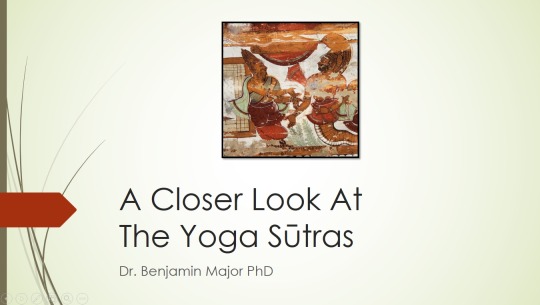
The Yoga Sutras are generally considered a foundational text of the yoga tradition. In this article we examine the context and background of the text, briefly explore its structure and content, and I also offer some reflections on the text’s relevance in modern times.
Note: I have decided not to use diacritics in this article. Diacritics are those little lines and dots above and below letters that tell you how to pronounce Sanskrit words. Normally I use diacritics in my writing, as they are essential for pronouncing Sanskrit correctly. However as this article is meant for non-scholars I have decided it would be better to try and write the Sanskrit words in a way that will make them easy to read and pronounce, so as not to put anybody off!
History & Context
Most scholars these days date the Yoga Sutras to somewhere between the 2nd and 5th centuries CE, with Philipp Maas placing it in the early 5th century.
The text is attributed to a sage named Patanjali. Biographically, we know next to nothing about Patanjali. The name is a compound word formed from the Sanskrit words pata (falling, flying) and anjali (the gesture of joining the hands together in reverence).
Yoga had already been around in some form or another for many centuries by this point. Therefore, Patanjali did not ‘invent’ Yoga. Nevertheless, this is the earliest comprehensive and systematic text on the subject that has survived.
Yoga was just one darshana or school out of many in ancient India. In terms of philosophy, it shares many similarities with the Samkhya school. But whereas Samkhya tends to emphasise the use of reason and knowledge to gain liberation, Yoga emphasises practical and experiential methods.
Philosophically, both the Samkhya and Yoga schools teach a form of dualism. This is a dualism between purusha (our true Self) and prakriti (everything else, including the body and mind) and the whole point of Samkhya and Yoga in a nutshell is to guide us towards the realisation of purusha, that is, our true Self. This is true liberation or moksha in Yoga.
Most of the ancient darshanas had their own sutra text. Sutra texts are known for their brevity. Basically, sutra texts are where the most essential teachings of a school are distilled into as few words as possible. Knowledge systems were handed down orally in ancient India and thus source material was kept minimal with a view to facilitating memorisation.
Other authors would then come along and write longer commentaries on these sutra texts. The Yoga Sutras have a rich commentarial tradition spanning many centuries. The first and most well known is the bhasya commentary by a certain Vyasa. Vyasa actually means something like ‘compiler’ or ‘editor’ so that probably wasn’t his actual name!
Some scholars even argue that Patanjali and Vyasa are actually one and the same person, though others would strongly disagree with this thesis. Either way, this commentary is indispensable when it comes to making sense of the sutras, and published versions of the Yoga Sutras tend to include the bhasya commentary or at least reference it.
As a final note, many scholars now use the term pātañjalayogaśāstra to refer to this text as a whole (sutras plus commentary), because that is the name our oldest existing manuscripts use. But to keep things simple we will continue to use the name Yoga Sutras!
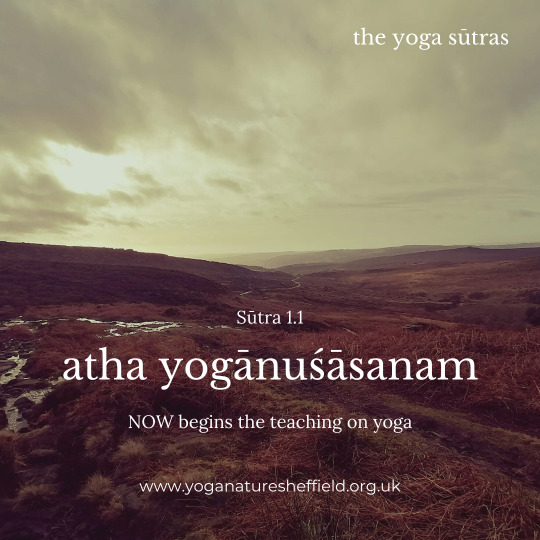
Structure of the Text
The Yoga Sutras are divided into the following four padas or chapters:
Samadhi Pada: This is where Patanjali defines Yoga and then describes the nature and the means to samadhi, the goal of Yoga.
Sadhana Pada: Sadhana is the Sanskrit word for practice or discipline. Here the author outlines two forms of Yoga, the kriya yoga (yoga of action) and the ashtanga yoga (the yoga of eight auxiliaries or limbs). This is also where Patanjali discusses the kleshas, five ‘afflictions’ or impediments to Yoga.
Vibhuti Pada: Vibhuti is the Sanskrit word for power or manifestation. Supra-normal powers (siddhis) are said to be acquired by the practice of Yoga. However, the temptation of these powers should be avoided and the attention should ultimately be fixed only on liberation.
Kaivalya Pada: Kaivalya literally means isolation. This is the chapter on final liberation. The Kaivalya Pada describes the process of liberation, it explains how the mind is constructed and veils the inner light of the Self.
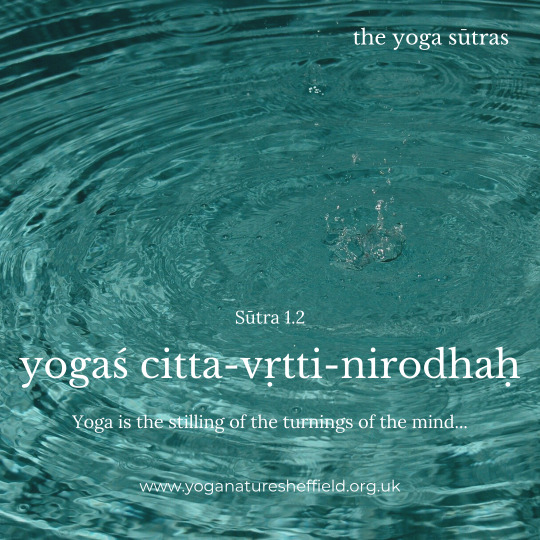
The Goal of Yoga
Not one for a lengthy preamble, Patanjali gets stuck right in there and clearly states the goal of Yoga in the well-known second sutra:
yogas chitta-vritti-nirodhah YS 1.2
Any Sanskrit sentence allows for a number of possible translations and this one is no different. A nice and accurate one is this one from Barbara Stoler Miller:
Yoga is the cessation of the turnings of thought
The reason I say this one is accurate is because a literal meaning of vritti is ‘turning’. Ever felt that thoughts are ‘going round and round’ in your head? Well this phrase nicely captures that! The vrittis in this statement refer to thoughts, emotions, ideas and basically any cognitive act of the mind. Patanjali lists five types of vrittis. These are, once translated:
Right knowledge
Error or false knowledge
Imagination
Sleep &
Memory
All such activities of the mind are products of prakriti and are completely distinct from the true Self, purusha, that pure awareness or consciousness which we are aiming to enter into through Yoga. The means prescribed by Patanjali in the first chapter of the Yoga Sutras to still the vritti states of mind are sustained practice (abhyasa) and dispassion (vairagya).
Specifically the practice offered is meditation, or keeping the mind fixed on any particular object of choice without distraction. Patanjali then describes a number of possible forms such meditation could take. By stilling all thought, meditation removes all objects of awareness. Awareness can therefore now be aware only of itself, of its own source, the true Self or purusha. This state is known as samadhi in Yoga and Patanjali makes it super clear that this state of samadhi is the goal of Yoga and thus the whole text is focused upon achievement of that goal.
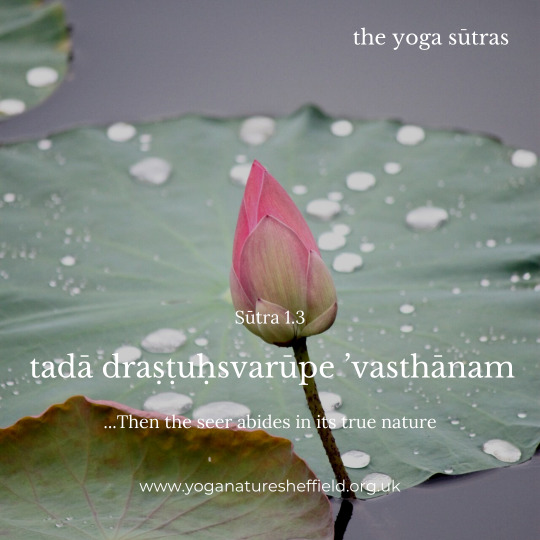
Obstacles to Yoga
Patanjali mentions five kleshas, which can be translated as impediments or obstacles to achieving samadhi and thus Yoga. These five are as follows:
Ignorance
Ego
Desire
Aversion
Clinging
In the Yoga Sutras, and indeed in ancient Indian philosophy in general, the first item in any list is the most important and fundamental. It’s the same here. Ignorance here means failing to recognise our true Self or purusha and instead identifying ourselves with our body, mind and the material world. All of the other obstacles arise from this fundamental error.
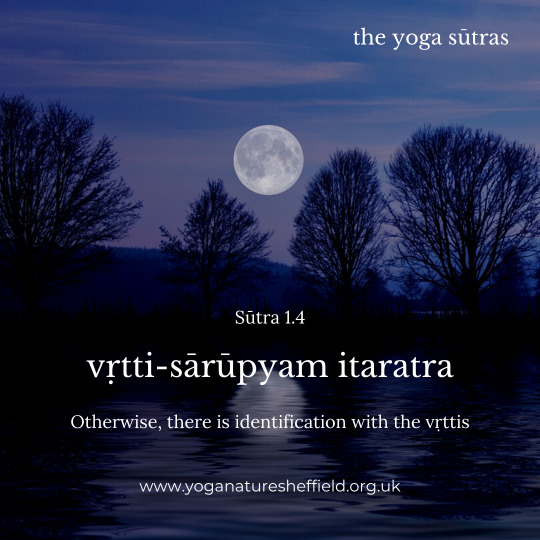
Yoga Psychology
Like most other schools of Indian thought, the Yoga school believed in the related concepts of karma and rebirth. According to this doctrine, we are caught in an endless cycle of rebirths called samsara and the purpose of following a path such as Jainism, Buddhism or Yoga is to bring an end to this cycle. Where the Yoga Sutras really shine are in interpreting this doctrine in a highly sophisticated ‘psychological’ way, to use modern terminology.
According to this Yoga psychology, the mind forms an impression of an object through the sense organs, which is called a pratyaya. Once this pratyaya or active image of this object is no longer of active interest to the mind, it becomes an inactive or latent samskara. A samskara is an imprint left in the chitta, somewhat like a sound is imprinted on a tape recorder, or an image on photographic film. In this way the vrittis, the activities of the mind, are retained as samskaras when they fade.
It is important to note that these samskaras are not just passive imprints but vibrant latent impulses that can get activated under conducive circumstances and can exert influence on a person’s thoughts and behaviours, even many years after the impression was made. What’s more, according to Yoga these samskaras can persist from previous lives. The chitta is thus something of a storehouse of these recorded samskaras, deposited and accumulated there over countless lifetimes. One is here reminded of the theory of the subconscious in modern psychoanalysis.
According to Yoga, karma is generated by the vrittis, and the vrittis, in turn, are produced by the kleshas. There is thus a vicious cycle of kleshas, vrittis and samskaras. To run through the whole cycle again to try and make it as clear as possible: vrittis are recorded in the chitta as samskaras, and these samskaras eventually activate consciously or subliminally, producing further vrittis. These vrittis then provoke actions and reactions, which in turn are recorded as samskaras, and the cycle continues endlessly, leading to much suffering along the way.
The whole Yoga project aims to bring this vicious cycle to an end and it is liberation from this mind created suffering that we are after as yogis. The Yoga Sutras are effectively a manual guiding us towards this end, this state of samadhi or complete meditative consciousness.

The Yamas and Niyamas
The second pada or chapter of the Yoga Sutras contains a famous exposition of five ethical restraints (yamas) and five ethical observances (niyamas) and these are relatively well-known in the modern yoga world. The first thing to get clear is that these yamas and niyamas are NOT original or unique to Yoga. All ascetic schools in ancient India had these ethical codes, and the exact same ones appear in Jainism for example. Sometimes, you even get more of them. Some yoga texts for instance list 10 yamas and 10 niyamas.
The five yamas listed in the Yoga Sutras are:
Ahimsa (non-harming) Satya (truth telling) Asteya (non-stealing) Brahmacharya (chastity or celibacy) Aparigraha (non-acquisitiveness)
The five niyamas are:
Shauca (purity or cleanliness) Santosha (contentment) Tapas (self-discipline) Svadhyaya (study) Ishvarapranidhana (devotion to the Ishvara or Lord)
Many of these could do with further explanation and commentary but there is not space in this present article. The other thing I want to stress is that these yamas and niyamas were not seen as optional extras for yogis. Rather, these were the bedrock of fruitful yoga practice. Patanjali and others refer to them as the mahavratam or ‘great vow’. Importantly, having listed the yamas, Patanjali devotes an entire sutra to reiterating just how central and non-negotiable these yamas are. Once translated, this sutra reads as follows:
[These yamas] are considered the great vow. They are not exempted by one’s class, place, time or circumstance. They are universal. YS 2.31
So, regardless of your social status, regardless of where you live, in which time period you live, and any other extenuating circumstances (such as your career), adherence to the yamas, including especially ahimsa, the foundation of them all, is an essential part of being a yogi as defined by Patanjali’s system.
Vyasa is even more emphatic in his bhasya commentary to the Yoga Sutras, and it is here that the link between ahimsa and vegetarianism is explicitly and unequivocally made, and several examples are brought to bear. Refer to the work of scholar Jonathan Dickstein to read more about the strong case for vegetarianism made in Patanjali Yoga.

The Ashtanga Yoga
These yamas and niyamas are just the first two parts of Patanjali’s famous ashtanga or eight-part path. I would first like to clarify that this systematisation of yoga into a series of angas (a word translated by some modern scholars as ‘auxiliaries’ but more commonly rendered as ‘limbs’) was again not novel to Patanjali. Throughout the yoga tradition we find various similar schemes, predating and postdating Patanjali, including fourfold, fivefold, sevenfold and even fifteenfold schemes. I would also like to stress that, despite sharing the same name, this ashtanga yoga bears little relation to the modern postural form of yoga known as Ashtanga.
Following the yamas and niyamas then, we then have the following six angas:
Asana (posture): At last I hear you cry, postures! In Patanjali’s day meaning a steady and comfortable seated posture, asanas today comprise a set of physical exercises which stretch and strengthen the body. It is this aspect of yoga that has been most visibly exported to the West but too often stripped from its context as just one ingredient in a more ambitious and far-reaching sequence.
Pranayama (breath control): Prana refers to the universal life force whilst ayama means to regulate or control, but it can also mean to expand and lengthen. Prana is the vital energy needed by our physical and subtle layers, without which the body would perish. It is what keeps us alive. Pranayama is thus the control or expansion of prana through the breath, depending on which definition of ayama you use.
Pratyahara (withdrawal of the senses): This limb further deepens the above process by removing consciousness from all engagement with the senses (sight, sound, taste, smell and touch) and sense objects.
This is followed by the final three limbs collectively known as samyama: Dharana (concentration, fixation), Dhyana (meditation), and finally Samadhi (the latter of which Patanjali further divides into seven rather esoteric stages). These last three limbs are essentially different degrees of concentrative intensity and culminate in the realisation by the Self of its own nature.
Just to reiterate one more time, it is this Self-realisation, the state known as samadhi, that is the true goal of Yoga.

Relevance of the Yoga Sutras for Today
In this brief introduction we have of course only scratched the surface of this incredible text, and there is much more that could be said. But for now I want to end with some concluding reflections on the continuing relevance of the Yoga Sutras in the modern world.
One question that arises is whether Patanjali was prescribing a strictly ascetic path. And indeed, the general scholarly consensus has usually been to associate Patanjali's Yoga exclusively with extreme asceticism, mortification, denial and renunciation. However, there are dissenting vocies. For example, Ian Whicher has repeatedly and passionately argued that Patanjali's Yoga can be seen as enabling a more responsible living in and engagement with the world, and that Patanjali was not advocating total renunciation. For Whicher, following the path of Patanjali can lead one towards that integrated and embodied state of liberated selfhood whilst living, a state known as jivanmukti.
Regardless of whether Patanjali was historically preaching ascetism or not, the fact remains that the Yoga Sutras are full of valuable ideals and tools for the practitioner living in the modern world. Let’s face it though, this is a challenging path. As a scholar and practitioner I often perceive a huge disconnect between the kind of yoga I am seeing on the likes of Instagram and the teachings of the Yoga school as presented in the Yoga Sutras. After, all, the former is highly focused on body image, whereas the Yoga of Patanjali is all about dissociating ourselves from our body and mind and recognising our true Self. However, this does not mean that the two are necessarily irreconcilable.
Though there is absolutely no historical evidence that Patanjali and his followers were practicing postural yoga (that didn’t come until later with the emergence of the Hatha tradition) nowhere in the Yoga Sutras does it say that physical exercise cannot be part of one’s yoga practice. We just have to remember that as far as Patanjalian Yoga is concerned, such postural activity is just a further means or method on the path towards samadhi or full meditative awareness. This is why any so-called yoga that does not contain more internalised meditational practices but which focuses solely on physical exercise should not really be called yoga.
The Yoga Sutras remains undoubtedly the most famous ancient yoga text, and it is studied to some extent in probably every yoga teacher training course. To be honest, I personally feel that too much emphasis is placed on the Yoga Sutras, at the expense of other branches and other texts of the tradition. The Tantric texts, in particular, are still sorely neglected. One of my own aims in my work is to try and decentre the Yoga Sutras and provide a much wider overview of the history and philosophy of yoga and the other related schools of ancient India. This is not to take anything away from the Yoga Sutras, however, as it is without doubt an extraordinary text that continues to be highly relevant in the 21st century.
Further Reading
I have already mentioned some scholars whose work you may wish to refer to, such as Philipp André Maas, Ian Whicher and Barbara Stoler Miller. For a translation and commentary on the Yoga Sutras that is both scholarly accurate and reasonably accessible I would recommend that of Edwin Bryant published by North Point Press.
11 notes
·
View notes
Text
Yoga Sutra 1.1: Atha Yoga Anushasanam
The phrase “be here now” is encapsulated in the opening aphorism of Patanjali’s Yoga Sutras: “Atha yoga anushasanam.” The word “atha” signifies a moment of readiness and intention—inviting the reader to be fully in the present moment to begin the study and practice of yoga. While this sutra is simple and straightforward, it’s an important call to action that frames the entire discourse of…
4 notes
·
View notes
Text
Maulungaputta

Once a great philosopher came to Buddha. His name was Maulungaputta. He was a well known philosopher. He had brought a mass of questions. Buddha listened to his questions and said, ”Maulungaputta, do you really want the answer? If you really want it, can you pay the price?”
Maulungaputta said, ”The end of my life is coming near. My whole life I have been asking these questions. I received many answers but no answer has proved to be an answer. From every answer new questions have arisen. The solution was not in any answer. What price do you ask? I am ready to pay the full price. I want only to solve these questions. I want to leave this earth with these questions solved.”
Then Buddha said, ”Good. People also ask questions but are not ready to pay the price. This is why I asked you. Sit in silence for two years, this is the price. Sit near me in silence for two years without saying anything. When two years have passed, I myself will tell you, ’Maulungaputta, now ask your questions.’ Then you can ask what you need to ask. And I promise that I will answer everything, I will dispel all doubts. But two years completely still and silent. Don’t bring it up for two years.”
Maulungaputta was thinking whether to say yes or no. Two years is a long time and who knows if this man can be trusted, will he answer even after two years or not? He asked, ”Do you give full assurance that you will answer after two years.
Buddha said, ”I give complete assurance, if you ask I will answer. But if you do not ask, who will I answer?”
At that time there was a disciple, a bhikshu, sitting in meditation under a tree nearby. He began laughing uproariously.
Maulungaputta asked, ”Why is this bhikshu laughing?”
Buddha said, ”You ask him.”
The bikshu said, ”If you want to ask then ask now. I was deceived in the same way. He made a fool of me too. But he is telling the truth that if you ask after two years he will answer, but who asks after two years? I have sat silently for two years. Now he goes on prodding me, saying ask brother. But after two years of remaining silent nothing remains to be asked, the answer is received. If you want to ask, ask now, otherwise after two years nothing will be left to ask.”
And this is exactly what happened, Maulungaputta stayed two years. When two years were over, Buddha did not forget, he remembered the exact date. Maulungaputta had forgotten when two years would be over because one whose thoughts have become slowly slowly quiet loses awareness of time. How to keep track of time, what day it is, what year it is! All was gone, all had flowed away. And what was the need? He would sit every day with the Buddha so Friday or Saturday, Sunday or Monday all were the same. June or July, hot or cold all were the same. Inside him there was only one vibe – of peace, of silence.
Two years were over. Buddha said, ”Maulungaputta, stand up.”
Maulungaputta stood up. Buddha said, ”Now you can ask, because I don’t go back on my promise. Do you have something to ask?”
Maulungaputta started laughing and said, ”That bikshu was right. Now I have nothing to ask. The answer has come. Through your grace the answer has come.”
The answer has not been given but it is received. The answer does not come from outside, the answer comes from within. Think of it like digging a well. First rocks and gravel are removed, rubbish is removed, dry earth is removed then wet earth, then mud, then flowing water… The flowing water has been suppressed. The layers and layers of your questions have collected, the flowing stream is repressed beneath all this. Dig, push these questions aside. And there is only one way to push them aside: as a witness alertly watch this stream of questions. Just go on watching this stream, don’t do anything. Sit every day an hour or two, let the stream flow. Don’t be in a hurry to stop it today. This is why Buddha said two years. After some three months the first rustling of stillness begins. And as two years are over the experience ripens. Only if one has enough patience to sit two hours everyday, not doing anything…
The whole art is hidden in this not doing anything.
#sutra#heart sutra#yoga sutras#rainbow#people#art#artwork#love#achintyam#Vibe#vibemantra#mantra#spirituality#life#music#blogger#stories
6 notes
·
View notes
Text
YOGA is the discipline (art & science) of being fully present in the moment we are experiencing right NOW.
~ Vimal sharma

https://yogasutra195.com/sutra-1-1/
#yoga philosophy#sprituality#mindfulness#psychology#meditation#awarness#conciousness#yoga sutra#yoga sutras#patanjali#power of now#self awareness
3 notes
·
View notes
Text

The Yoga Sutras of Patanjali, Land Sky Oracle, & garden picked wildflowers = abundant in simplicity, in access to yogic wisdom, and open to the higher message. or just a peaceful morning ✨️
instagram| bodhi.yogini
7 notes
·
View notes
Text

Ashtanga Vinyasa Yoga
Prática gradual e efetiva;
Até quatro alunos por grupo;
Para todas as idades;
Instrução com 15 anos de experiência.
MANHÃ/TARDE/NOITE
AULA EXPERIMENTAL GRÁTIS
5 notes
·
View notes
Text
youtube
Liberation and Independence, The Yoga Sutras of Patanjali
#patanjali#yoga sutras of patanjali#yogasutras of patanjali#yoga sutra#patanjali yoga sutras#yoga sutras#patanjali yoga sutra#the yoga sutras of patanjali#yogas sutras de patanjali#ashtanga as a means of liberation#les yoga sutra de patanjali#les yoga sutras de patanjali pdf#yoga sutra patanjali français#yoga sutra patanjali#sutras#yoga sutra patanjali pdf#patanjalis yoga sutras#sutra de patanjali#patanjali sutras#what is the purpose of yoga sutras#Youtube
1 note
·
View note
Text
Una citazione di Patanjali da parte di Guru Dev per purificare la mente: Maharishi Patanjali, autore degli Yoga Sutra, ha fornito le seguenti istruzioni: Mantieni la mente in uno di questi quattro stati: maitri (cordialità), karuna (compassione), mudita (gioia) e upeksha (indifferenza)". (YS 1.33) Bisogna provare un sentimento di amicizia verso le persone che sono come noi e provare compassione per i subordinati o per chi sta attraversando un momento difficile. Con le persone più felici, più sagge o più istruite, o che vi superano in qualche modo, assicuratevi di guardarle con un sentimento di felicità. Con le persone che nutrono sentimenti di malignità e ostilità nei vostri confronti, invece, dovete adottare un atteggiamento di indifferenza, in modo da non ricambiare questo sentimento di inimicizia e odio. In questo modo, tenendo a mente queste quattro condizioni mentali, non sorgeranno nella mente sentimenti come invidia, malizia, gelosia, ecc., e la purezza innata della mente crescerà. In questo modo, non si verificano ostacoli negli affari di tutti i giorni. Con la scomparsa della sporcizia mentale, diminuisce il desiderio istintivo di esperienze sensuali e per questo motivo la mente diventa introversa e si impegna nell'adorazione di Bhagavan (Dio).
0 notes
Text
Introduction to Raja Yoga: The Path of Meditation and Mental Discipline
Raja Yoga, often called the “Royal Path,” is the yoga of meditation and mental discipline, guiding practitioners to control the mind and senses, and ultimately to attain self-realization and spiritual enlightenment. It is considered one of the most comprehensive forms of yoga, encompassing aspects of all the other yogas, and is particularly focused on the systematic cultivation of the mind…

View On WordPress
#Advaita Vedanta#Ashtanga Yoga#Eightfold Path#emotional stability#enlightenment#Inner peace#meditation#Mental Discipline#Patanjali#Raja Yoga#Ramakrishna#Royal Path#Self-Realization#Spiritual Awakening#spiritual growth#Swami Sivananda#Swami Vivekananda#yoga philosophy#yoga practice#Yoga Sutras#yoga teachings
0 notes
Text
6 books to understand yoga completely
The Yoga Rahasya of Nathamuni This ancient text by Nathamuni explores the esoteric and philosophical aspects of yoga. It delves into the deeper mysteries and hidden knowledge of yoga practice, providing a comprehensive overview of the subject. This book is a valuable resource for those seeking a deeper understanding of yoga beyond the physical postures.
The Healing Power of Mudras: The Yoga of the Hands This book explores the therapeutic benefits of hand mudras, or sacred hand gestures, in yoga and meditation. It explains how simple hand positions can rejuvenate the body, heal ailments, and facilitate spiritual awakening. This text is a valuable resource for those interested in the healing aspects of yoga.
Yoga Secrets of Psychic Powers This text uncovers the hidden yogic techniques for developing psychic abilities and supernatural powers. It covers practices to awaken the third eye, enhance intuition, and access higher states of consciousness. This book is a valuable resource for those interested in the spiritual and mystical aspects of yoga.
Vasistha Samhita (Yoga Kanda) The Vasistha Samhita is an ancient yoga scripture that delves into the advanced practices and philosophical underpinnings of yoga. The "Yoga Kanda" section focuses specifically on the technical aspects of yoga, providing a comprehensive guide to the subject.
A Systematic Course in the Ancient Tantric Techniques of Yoga and Kriya This comprehensive text provides a step-by-step guide to the ancient tantric practices of yoga and kriya. It covers a wide range of techniques for physical, mental, and spiritual development, making it a valuable resource for those interested in the spiritual and mystical aspects of yoga.
The Yoga Sutras of Patanjali The Yoga Sutras, compiled by the sage Patanjali, is the foundational text outlining the eight limbs of classical yoga. It is an authoritative guide to the philosophy, psychology, and practice of yoga, providing a comprehensive overview of the subject. This book is a valuable resource for those interested in the philosophical and spiritual aspects of yoga.
0 notes
Text
A Course in Witnessing Blossoms
Covid changed the entire landscape. Out of the garden of our in-person meditation gatherings, A Course in Witnessing grew. We did not have any intention to create it. But covid changed everything. We had been holding almost weekly meditation meetings wherever we happened to be living. They had started in Prescott, AZ, moved to Gainesville, FL, and on to the Atlanta area. But covid created the…

View On WordPress
#A Course in Witnessing#awareness#Consciousness#Enlightenment#Meditation#No-Mind#Osho#The Book of Secrets#the Upanishads#Vigyan Bhairava Tantra#witnessing#yoga#yoga sutras#Zen
0 notes
Text
Did You Know What Jesus Said Between His Ages 12 to 30? Lent Is The Time To Learn All That Jesus Said
Have you ever made a puzzle with half of the pieces missing? Do you get the complete picture if half the puzzle is made? What if others made up what was in the missing pieces because it was too powerful for you to know, according to them? What if others scared you and your eternal Soul by saying those missing pieces were apocryphal, which only means hidden knowledge, not anti-Jesus, nor…

View On WordPress
#Abbot George Burke#Bhagavad Gita#Bible#Bible Study#Creation#God#Gospel of Thomas#Holy Spirit#India#Jesus#Lent#Nag Hammadi Scrpitures#Sermon on the Mount#Swami Nirmalananda Giri#The Christ of India#The original story of Creation#Upanishads#Yoga Sutras
0 notes
Text
Yoga Sutra 1.14: Creating Dedication, Depth, and Devotion
The ancient sage Patanjali revealed in his yoga sutras how we can still the thoughts in the mind. His formula for inner peace is simple and straightforward—a sustained meditation practice that contains dedication, depth and devotion—yet the application of Sutra 1.14 requires patience, perseverance, and a heartfelt commitment. What Does Yoga Sutra 1.14 Mean? This Sanskrit sutra “Sa tu…
2 notes
·
View notes
Text
The Power of Maitrī: Cultivating Loving Friendships for Material and Spiritual Well-Being
The practice of Maitrī, as defined in the sutras of Patanjali, involves cultivating a loving and caring friendship with oneself and others. This encourages strong, meaningful relationships, leading to happiness, productivity, and a sense of purpose.
In today’s fast-paced world, it is easy to get caught up in the hustle and bustle of our daily lives. We often forget the importance of connecting with ourselves, our family, community, and society on a deeper level. As human beings, we all crave love and connection, and one of the most powerful ways to cultivate this is through Maitrī. In the sutras of Patanjali, Maitrī is defined as the…

View On WordPress
#energy#health#healthy lifestyle#loving friendships#Maitri#material well-being#Michelle Berry#Michelle Berry Bliss#spiritual-wellbeing#wellness#Yoga Sutras
0 notes